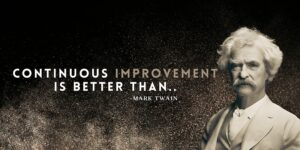Online shopping has redefined our buying behaviours, although it’s harder to form lasting ties between the products and their consumers.
In this changing world of flux, our minds are rewired to feel comfortable in buying unfamiliar brands from their ubiquitous online platforms. And these changing habits may also be making us less loyal to anything we buy. This is a challenge that every brand would be struggling with today.
There is a need for consumer brands to reboot their businesses in view of the disruption and the changing consumer behaviour today.
Businesses need to realign their business models, enhance consumer experience through technology and analytics, build resilient distribution, develop their omni-channel presence, operate efficiently, and thrive by focusing on sustainability.
Newer shopping destinations like Amazon that advertise on relatively low-cost social media mediums having online customer reviews have recorded how we evaluate and buy products and services. It’s interesting to note, though offers great challenges to the marketers.
The ubiquitous internet and the proliferation of digital economy along with the popular social media platforms have today offered us choices that the earlier time’s brick and mortar market didn’t. In earlier times, the retailers used to make the choices for us.
But it’s changed today completely where the invisible customers are deciding everything, though being influenced by several related factors and media-mix and from the gazillion choices on offer on the Amazon and Flipkart. Interestingly today, we are more open to trying newer things and good products could break through, with a little more sincere and thoughtful effort though.
But, the challenges for the marketers remain on forming a lasting relationship for brand loyalty, what with information overload, deluge of options, spoilt for choices and even the glossy Ads.
Onset of the digital economy and availability of online channels have not just offered the consumers multiple options with easy online payments but has also lessened the associated selling budget of the producers thereby offering them more windows to play around their prices. Consumers benefit immensely from such scenarios.
Brands must communicate in very local and precise terms, targeting specific consumers based on their circumstances and what is most relevant to them.
Word of mouth and community based opinions could help influencing our choices to certain extent, though it doesn’t guarantee in the long run as our habits and behaviour have changed totally.
The EY Future Consumer Index, which has conducted five waves of research with 14,500 individuals in 20 countries since the start of the pandemic, has identified five different cohorts of consumers:
- Affordability first (32 percent of consumers): Living within their means and budget, focusing less on brands and more on product functionality.
- Health first (25 percent): Protecting their health and that of their family, choosing products they trust to be safe and minimizing risks in the way that they shop.
- Planet first (16 percent): Trying to minimize their impact on environment and buying brands that reflect their beliefs.
- Society first (15 percent ): Working together for the greater good, buying from organizations they find to be honest and transparent.
- Experience first (12 percent ): Living in the moment to make the most of life, often making them open to new products, brands, and experiences.
Independent reviews are good guidance acting as influencers for the discerning consumers but read often with a pinch of salt by the doubters as many are manipulated or are paid reviews.
However, it’s prudent for the marketers to keep an eye on these review sites to not just gauze the customer’s pulse but to correct perceptions, when spoken wrongly or misguided.
Several top global brands invest in such sites and keep the influencers and connoisseurs engaged with them for improvement and to feed them correctly, helping them broadcast all things good about the product and the company.
Well, all these could prevail only when the quality and value-for-money remain constant, in India’s price sensitive market, unless your product is positioned in the premium category with some monopoly.
The current pandemic has not just disrupted lives and livelihood but has affected our buying pattern, when physical interaction gives way to virtual transactions. Thus our buying behaviour changes and hence, the marketers are adopting different marketing strategies.
Storytelling is essential to businesses. Create your narrative to help you reach the right audience, broadcasting your goal and objectives. Reimagine the very art of storytelling as everything around seems to be in a state of flux. Put the customer at the centre of all communications, putting people at the heart of the tale.
In the changing market scenario, with the changing customer profile, you are not just competing with your customers but most importantly, you are going to compete more with the last experience your customer had.
And this is a bigger challenge you will face daily hence, consistently maintaining the quality in every aspect of your product reaching your customers would acquire much significance, which will always keep you on your toes. And the market is like online-dating today.
Customers keep searching for variety and better product match in the vast market. So, relationships are everything here that needs constant nurturing and building up on trust and acceptance. It is not just your products but the values it carries and speaks of, which will have a greater say in influencing your customers.
Marketing should be at the centre of your growth agenda. It should not be and cannot be seen as your business’s cost centre, inviting cuts when the topline results get compromised.
During the pandemic, marketing has been elevated as a driver of digital transformation in your campaign, a key tool of the customer journey, and the voice of the consumer — all of which are of paramount importance to other functional areas and tools. There should be a confluence of strategies, operations and technologies required to drive growth in this pandemic world, prioritising customer perspectives.
Brands are a symbol of trust, which symbolises assurance, consistency and tells you what to expect.
Trust is reliability + delight, which is built over time with regular communication and consistency in product quality, packaging and delivery- creating expectations, meeting & exceeding them plus offer experience.
All these are hardest to achieve in the online world with choices abound. In a market where there’s choice, they are differentiating themselves.
With such information overload and we being spoilt for choices, marketers discovered ways and means to stay relevant, connected and visible in order to influence and induce consumers to follow, accept and use their wares.
Through digital marketing and with clever use of various technologies, marketers are designing algorithms that profiles their customers, follow their buying behaviour, their choices, likes and dislikes and even opinions and views. They are today trying to influence us at every outing on the internet, in everything that we are thinking and doing.
We just can’t escape their omnipresent, powerful web of clever net. Did you ask about your privacy? Forget it as long as you are active on the internet, on the digital world, on the cyberspace. You can’t have the cake and eat it too. It’s like the allopathic medicines that either stay muted on various side-effects or the fine prints escape our attention. To get some, you lose some!
Consumerism is all pervasive as the market wants us to consume as much. Competition and even greed drive the aggressive producers and their marketers to deploy various decision inducing tools and mechanisms.
The market compelled endless race for a healthy bottom-line and growing top-line, will continue to force on the consumers, all the available marketing tools that could help their cause and sustainability.
Market dynamics and changed situations pushes the marketers to try and use different techniques and intelligent software tools such as data analytics, artificial intelligence (AI), block-chain, machine learning (ML) and internet of things (IoT) mostly targeting our handheld communication devices, over and above the conventional market-mix strategies, engaged on the print and electronic media.
Similarly the designer professionals are using user interface (UI) and user experience (UX) towards consumer behaviour and choices of products shown on the digital world. Virtual reality (VR) and augmented reality (AR) are being used for a real world experience on the digital platform.
Everyone is relentlessly after us, chasing us everywhere. It is innovative marketing strategies during challenging times.
Even the TV news channels have trained their guns on the viewers to turn them consumers hence, it’s no more news dispensing channels with reporters rather they also have turned mind influencers, opinion makers and even propagandists with missionary zeal.
You are made to believe their churned stories. Everyone wants to influence the decision makers and to create their followers. Consumerism is here to stay and marketers will continue to chase us everywhere, each time we follow them, on the digital media and on the internet.
(Disclaimer: The views and opinions expressed in this article are those of the author and do not necessarily reflect the views of YourStory.)










![Read more about the article [YS Exclusive] Bioethanol startup MicroBite raises $1.5M in Pre-Series A from Vijay Madduri, others](https://blog.digitalsevaa.com/wp-content/uploads/2022/03/microbite-1648566383279-300x150.png)